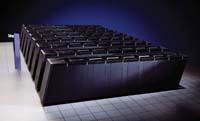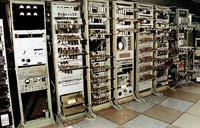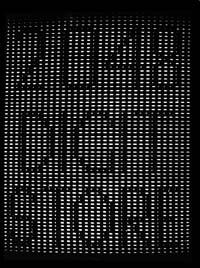The Baby: the first electronic computer
2006/06/01 Lasa Oiarbide, Aitzol - Elhuyar Zientziaren Komunikazioa Iturria: Elhuyar aldizkaria

It was difficult times that came after World War II. All of Europe was turned upside down by the war. During the reconstruction, the means used in recent years for war were used. A curious example is the German, in which materials from the air navy were used to manufacture cars for civil society. But not only materials. Scientific knowledge, kept secret during the war, remained to some extent in the hands of civil society.
First computer computer
During the war, the British government carried out several attempts to devise machines that would automate mathematical processes. These machines were initially used to decipher German secret codes. But, after the war, they took advantage of this technology to build the first civil computer.
This experimental computer was called SSEM -- Small Scale Experimental Machine, or Experimental Small Medium Machine, but scientists at the University of Manchester who participated in his invention gave him a sweeter name, The Baby , or Umetxoa.
The Baby had all the elements that a current computer has, but, as its name indicates, to a small extent. It used, among other things, binary arithmetic, a simple code language, a memory of 2.048 bits and a speed of instruction of 1.2 milliseconds.
Unlike the current computers, the curious thing is how memory was. In fact, the memory was a CRT screen size 32 x 32 pixels, that is, a conventional one-color television of 6 inches in length. The Baby had two screens of this type that gave it its memory of 2.048 bits --starting with 32 pixels x 32 pixels x 2 screens = 2.048 bits -.

When the electrons of the cathode tube collided with the phosphorus of the screen, they wrote on screen 0 or 1 information, the two possible values that can take a bit. This screen was similar to a current RAM. In addition, The Baby had no other hard drive. This means that the programmer had to enter in the same memory of the screen the commands and execution data of the program and that once the program was launched, all calculations were produced on the screen itself.
When the time of the first test came, everything went well. The Baby was commissioned to calculate the largest factor of a number and met his work quickly and successfully. We must recognize that the first number was relatively small. However, after a few days with improvements, The Baby calculated the highest factor of number 2 18 -- and for those who do not know, this number is extremely large. The calculation took 52 minutes.
And the baby got toothed
Experiments with The Baby gave good results and began to design a larger machine based on this technology. This machine was named Manchester Mark 1. Subsequently, the design of this machine was used to build the first commercial prototype.

The machines built commercially were called Ferranti Mark 1, as Ferranti was responsible for its construction. But since that name was long, Mark 1 became popular.
Ferranti sold the first machine produced at the University of Manchester. Subsequently, nine other machines were officially built, as it seems that two others were secretly sold to the British government. It is considered that these two special machines underwent modifications in their design, so they were more effective than the traditional Mark 1. Between 1951 and 1957 it was sold to several universities and governments of Europe and America.
To the present day
At home, at the ikastola and at work. In the library, the museum and almost everywhere. It would be unthinkable our day to day without computer. It is little more to know that computers that have become a common tool are the successors of the little The Baby.




